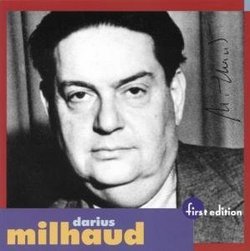| All Artists: Darius Milhaud, Robert Whitney, Jorge Mester, Louisville Orchestra, Paula Seibel Title: Darius Milhaud: Ouverture Méditerraneénne; Kentuckiana; Cortege Funebre; etc. Members Wishing: 2 Total Copies: 0 Label: First Edition Release Date: 10/12/2004 Genres: Pop, Classical Styles: Vocal Pop, Opera & Classical Vocal, Forms & Genres, Theatrical, Incidental & Program Music, Historical Periods, Modern, 20th, & 21st Century, Symphonies Number of Discs: 1 SwapaCD Credits: 1 UPC: 809157003120 |
Search - Darius Milhaud, Robert Whitney, Jorge Mester :: Darius Milhaud: Ouverture Méditerraneénne; Kentuckiana; Cortege Funebre; etc.
 | Darius Milhaud, Robert Whitney, Jorge Mester Darius Milhaud: Ouverture Méditerraneénne; Kentuckiana; Cortege Funebre; etc. Genres: Pop, Classical |
Larger Image |
CD Details |
CD ReviewsRare but typical Milhaud Discophage | France | 11/10/2007 (3 out of 5 stars) "It's hard to think that Darius Milhaud was considered in the twenties as one of the major composers of modern music. Maybe he was too prolific to maintain constant quality, or maybe (and more likely) his distinctive style was very much of its age, partaking of the insouciant spirit of the 1920s, but unlike Stravinsky, Milhaud never really evolved, except for maybe mellowing with the years. Outside of some of his earlier compositions such as "La Mort d'un Tyran" or some passages in "Les Choéphores" and in his opera "Christophe Colomb", which develop genuine and seizing power, I could never muster much enthusiasm for his music, hearing in it a pervading mood that to me sounds like fabricated merriment.
Anyway, this well-filled (66:30) reissue of Louisville recordings offers a good overview of Milhaud's style in the 1940s and 1950s. In fact the works featured here were written between 1939 ("Cortège Funèbre") and 1955 (the 6th Symphony, part of the remarkable batch commissioned by the Boston Symphony Orchestra for its 75 Anniversary - which, among others, included Martinu's 6th Symphony, Sessions' 3rd, Schuman's 7th, Piston's 6th, Villa Lobos' 11th -, and premiered by Charles Munch. The disc's main value then is to feature not the most famous and often-trodded Milhaud of Saudades do Brazil, Boeuf sur le Toit and Création du Monde, but these lesser-known compositions. The style remains remarkably Milhaud's own. "Overture Méditerranéenne" and "Kentuckiana (Divertissement on Twenty Kentucky Airs)" were two Louisville commission. There is nothing particularly distinctive in the overture (nor anything that sounds particularly Mediterranean either), Milhaud seems to be going through the motions. The 1954 mono recording sounds somewhat distant, and the same is true with Kentuckiana, made a year before. Ever gluttonous, Milhaud couldn't satisfy himself with writing a Divertissement on just one or two popular songs, so he picked twenty and shuffled them together. As could be expected, it sounds like the most would-be boisterous Americana of Copland's Rodeo and Billy the Kid. Milhaud is fishing so hard for the popular clap as to make it, for me, a not entirely pleasurable listening experience. Cortège Funèbre (Funeral Procession) is a much better piece, a funeral march of intense power, colored by sonority of Milhaud's favored Saxophone. It sounds very much like music Honegger might have composed for an Abel Gance film - and not surprisingly, as it derives from the music Milhaud composed to accompany the end of André Malraux' only film, after his novel "L'Espoir", on the Spanish Civil War. One is astounded to see that in 1966 Louisville was still recording in mono. The two last compositions come in good, 1974 stereo sound. Quatre Chansons de Ronsard is an endearing composition that should have been written in the 1920s. It is fresh and light-hearted, with even traces of Saudades do Brazil in the 3rd Song. Paula Seibel sings with a pure and twirling nightingale's voice and an acceptable French accent. First Edition Music must be lauded for providing texts and translations. In the first and third movements of the Symphony the mood is woodwind-led pastoral and lyrical, very much in American Prairie-style of Copland, Thomson and Harris at their most lyrical and pastoral. In between comes a darker 2nd movement, noted "tumultuous", more whimsical and varied in mood, a scherzo of sorts. The finale is animated, very typical of Milhaud in its overt and somewhat hollow optimism. The Symphony is not a very memorable piece, but it is interesting to hear how Milhaud's particular stylistic hallmarks (the slightly grating clashes of tonalities, the flaunted light-heartedness) blend with a typically American, epic and prairie-style so typical of the 1940s. Good notes. " |
